
Folktale and Fantasy at the Hundested Sand Sculpture Festival.
In Part 3: CASUAL JAUNTS THRU SWEDEN and DENMARK, we discovered that no matter how many times we visit Denmark, there is more to see, more traditions to learn, and more tasty meals to devour with our friends and their families. In this final section, we excitedly greet new adventures.
WHAT WE DID:
You might say Denmark is structured on limestone, beginning in the 11th century when it was used to build churches. One of the more famous limestone attractions is Mønsted Limestone Caves in Central Jutland. The caves have roughly 37 miles of underground paths, some leading into cavernous halls. The mines have become so popular that now tram rides and guided tours are available. We didn’t go there (next time), but we did have two “limestone quarry” experiences.
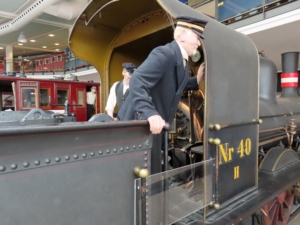
Vingettes showcase vintage trains depicting Denmark’s history.
Karlstrup Kalkgrav (Lime Quarry) in Solrød is considered Zealand’s clearest lake. The lake’s trout are edible. The azure water drinkable. Scientists come to Karlstrup to study fossils and evolution. Even non-scientists like us could see black lines denoting geologic periods etched into the quarry’s shoreline walls. Hikers, picknickers, and bird watchers flock to the park surrounding the lake. As it had rained just enough to muddy the ground, we had to step carefully over slippery broken rocks and tree roots crisscrossing the paths.
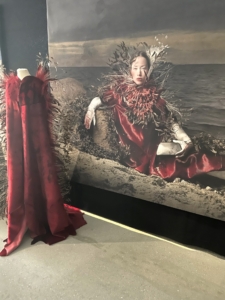
Posing dramatically against lime quarry rocks.
Our other “limestone quarry experience” was vastly different. The day was briskly windy with predicted spurts of rain, so we headed to Geomuseum Faxe.
The museum abuts the vast Faxe limestone quarry. The land beneath rested under the sea 63 million years ago before evolving into a vibrant coral reef rife with snails, crabs, sharks, and crocodiles. Erik and Russ contemplated the downstairs permanent hands-on exhibition “Denmark’s Fossil Coral Reef,” examining samples of fossils still found embedded in the limestone quarry. There were many young kids at the museum watching videos and playing with interactive exhibits describing fossils and rock fragments.
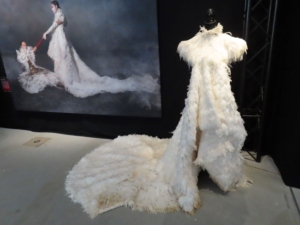
One of the fabulous photos and costumes made for the exhibit by Danish designer Jim Lyngvild.
Else and I made a beeline upstairs to gawk and admire the work of Jim Lyngvild, a Danish designer, writer, and photographer known as The Shapeshifter for his ethereal odes to spiritual beings in Greenland mythology. The exhibit includes a documentary playing on a loop of the planning and production of the full exhibition. Oversized photo images hang from walls of models posed in extraordinary furry, feathery or sealskin costumes, masks, and headpieces against a backdrop of the bleached, rocky quarry or lying in shallow water as if beached. Actual costuming and accessories from the shoot were placed near the captured photographic images. As I gaped from the detailed costumes to the hauntingly powerful photography, I thought the costumed models resembled romanticized “Game of Thrones” characters; then I discovered one of the models is actress Nukaka Coster-Waldau, the wife of Danish actor Nikolaj Coster-Waldau, who played Jaime Lannister on Game of Thrones.

An impressive church in Odense.
We took the quite short ferry boat ride to Odense, the country’s third largest city. In the center of the walkway lined with shops and restaurants stands a tall statue of King Knud, who ruled from 1080-1086. Catholics blessed him as a martyr and crowned him with Sainthood.
We were in Odense for the Danish Railway Museum (danmark jernbanemuseet). While Else and I browsed shop windows and pondered the enormous naked prone statue of a nameless woman on which kids climbed merrily, Russ and Erik toured the train museum, said to display Denmark’s history laid out on 21 tracks of the engine-shed. Interestingly, the Danes’ railroad story began in the Duchies of Schleswig-Holstein (where Russ’ ancestors lived as farmers). The men exclaimed this the best railroad museum they had ever visited. I know Russ was happy by how he posed proudly in his new railway museum cap.
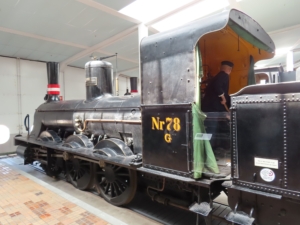
One of the displayed trains at the Danish Railway Museum.
Tip 5: Danes are liberally open-minded. Waiting on the dock for the ferry boat several people faced the water and nonchalantly changed from wet bathing suits into biker shorts and tops. No one gaped. No one cared.
Tip 6: Real Danish pastries are flaky, not doughy. They also call Danish pastry (as Americans know it), Vienna bread.
Tip 7: Rhubarb in season is a component of drinks, crumb cakes, pies, and in salads in both Sweden and Denmark.
Tip 8: Taking a nap is called a grandpa (the mother’s father).
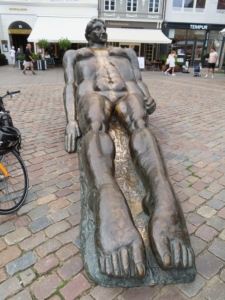
This prone statue in Odense becomes a playground for kids and a photo op for others.
I have been to sand sculpture competitions before, but they were always on a beach and not meant to be an event that lasts from mid-May through late October like the Hundested Sand Sculpture Festival at Hundested Harbor. Although I’ve seen videos and photos from contests held in exotic destinations, this is the first time I’ve personally seen sculptures composed of a clayed mixture that allows them to be outdoors and inside. The theme this year is Once Upon A Time and covers a mix of fairytales and folktales.
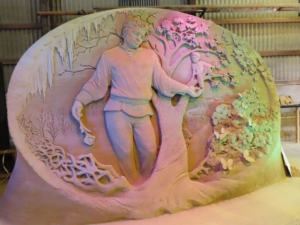
A beautiful vignette in sand.
Giant sculptures included a full vignette of demons attacking a sailor to the whimsical interpretation of the Old Woman Who Lived In A Shoe. The sculptures were inspired by authors such as H.C. Andersen or Oscar Wilde. Artists represented a variety of backgrounds and places of origin, from Russia to Canada, from Belgium to the Czech Republic, America and to many points between. The family-focused festival has many interactive components, from options to do sand painting or to try one’s hands at sculpting.
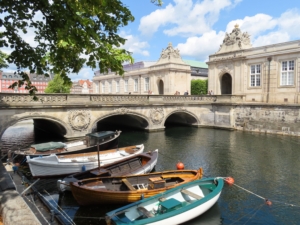
Entrance to the Parliament Building in Copenhagen.
After our negative experience parking the car in Copenhagen, we opted to take the local half-hour train ride into the city to visit the Danish Architecture Center. What a fun, interactive five-story facility. There was a three-story closed-in looping-twisting slide for children of all ages to go down on provided cloths, a large shop of architecturally questionable gifts and loads of books, as well as a cafeteria. We were there to see the So Danish! Living Architecture and Design exhibit, an overview of Danish architecture from the Viking Age to modern times. We saw designs’ evolution in furniture, lighting, and innovative ways to invigorate usage of outdoor environs. The exhibits examined how citizen input and active community involvement contribute to Danes often being named as some of the happiest people on earth.
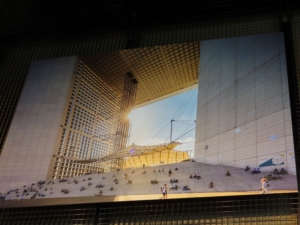
A photo inside the Danish Architecture Center.
In 2023, Copenhagen became only the second city designated the World Capital of Architecture by UNESCO, a title it will hold for three years. The first winner was Rio de Janeiro in 2021.
We also stopped by a church in Jersie where Else and Erik were married. The original construction was in the 1100s, added on in 1315, and the chapel in which they married in 2002 was erected in the 1500s. The grounds surrounding the small church are meticulously manicured with flowers and headstones.
On another afternoon we visited Juegerspris Slot (the castle in the forest) that belonged to Frederik VII. Jægerspris Castle sits in Jægerspris on the Hornsherred peninsula west of Copenhagen. The Danish manor house was built over six centuries beginning in the 13th century under the supervision of a succession of Danish monarchs. The original location was in the forest Hornsved, owned by King Valdemar Sejr in 1231. When in the area, he stayed at a farm called The Royal Estate Abrahamstrup. Abrahamstrup became the first name of the castle when erected in that same spot.
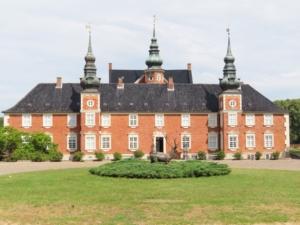
Juegerspris Slot (the castle in the forest) that belonged to Frederik VII.
Frederick V took possession of the castle in 1743, followed by his heir, King Christian IV, and then Frederik VII. The castle isn’t as large as others Russ and I have toured, but it has been carefully preserved. We viewed Frederik VII’s study, featuring his collection of more than 80 pipes of various sizes and shapes, the audience room with four plaster casts embedded in the ceiling of famous Danish sculptor Bertel Thorvaldsen’s bas-reliefs dating to 1856, and the countess’ chambers. Frederik VII became king in 1848. Shortly afterwards, he signed the Danish Constitution, ending the absolute monarchy and creating a constitutional monarchy.
There is an exhibit of golden national heritage treasures and one section devoted to the history of the children’s home begun by his wife, Countess Danner, in 1867. Within a few years the original 12 girls became more than 340 children to find a home within one of 17 sections of the castle grounds. Countess Danner, a non-Royal who had been a ballet dancer until sidelined by a knee injury, married the King in 1850, contrary to the wishes of his advisers. She died in 1874, a year before the foundation she wanted established to benefit poor and abandoned girls came into fruition.
Our third trip to Denmark ended, but it doesn’t mean there aren’t many more things to see and do with our dear friends, Else and Erik. Can’t wait to see what we get up to next time.
Karen Kuzsel is a writer-editor based in the Orlando area who specializes in the hospitality, entertainment, meetings & events industries. She is an active member of International Live Events Association and Meeting Professionals International and is now serving on the 2022-2023 MPI Global Advisory Board for Small Business Owners. She is a member of the Society of Professional Journalists. Karen writes about food & wine, spas, destinations, venues, meetings & events in her blog, Hotel Happenings & Program Promotions. A career journalist, she has owned magazines, written for newspapers, trade publications, radio and TV. As her alter-ego, Natasha, The Psychic Lady, she is a featured entertainer for corporate and social events. Karen@KarenKuzsel.com; www.KarenKuzsel.com; www.ThePsychicLady.com; @karenkuzsel; @thepsychiclady. She is also active with Experience Kissimmee CVB and Wedding Venue Map. Food photos for this series by Karen Kuzsel. All other photos by Russ Wagner, a retired government planner/builder who has a passion for historic architecture, wine, trains, travel and taking photographs.
